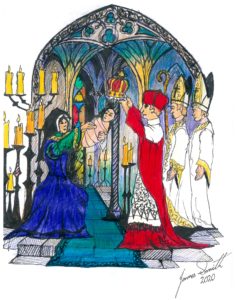Mary, Queen of Scots: Born on Friday, December 8th, 1542, in Linlithgow Palace, and only surviving child of King James V (of Scotland) and his second wife, Mary of Guise. Mary was born, as her father lay dying after the Scots suffered a humiliating defeat at the “Battle of Solway Moss”. On hearing that the baby was a daughter, King James is reputed to have said “It cam wi’ a lass and it will gang wi’ a lass”. The Stuarts gained the throne (of Scotland), through the marriage of Marjorie Bruce (daughter of Robert the Bruce) and Walter Stewart, Sixth High Steward of Scotland.
Mary was six days old when she inherited the throne, so until her adulthood, Scotland was ruled by regents. There were two claims to the regency: the first was the Catholic Cardinal Beaton and secondly was the Protestant Early of Arran. In order to break the “Auld Alliance” between Scotland and France, King Henry VIII of England used the regency to propose marriage between the infant Mary and his son and heir, Edward, hoping to unite both Scotland and England. The marriage was promised when Mary was ten years old, and moved to England.

Mary was crowned in a solemn ceremony in the chapel of Stirling Castle when she was just nine months old. The rejection of the marriage, Greenwich treaty by the Parliament of Scotland, plus the renewal of the “Auld Alliance” prompted King Henry to pursue the “Rough Wooing”, a military campaign to enforce the marriage between Mary and his son, Edward. On the 10th September, the Scots suffered a major defeat at the Battle of Pinkie Cleugh.

Fearful for her safety, Mary was taken to Inchmahome Priory by her guardians. Henry II of France proposed to unite France and Scotland, by marrying the young queen to his son, the three year old Dauphin of France. Arran agreed to this marriage. Mary was moved a second time for her safety to Dumbarton Castle. This time, the English left a trail of devastation behind them once more. On July 7th the Scottish parliament was held in a nunnery near the town of Haddington, which the Scots had claimed back from the English agreed to this marriage. With this marriage arrangement Mary was sent to France where she remained for the next thirteen years.